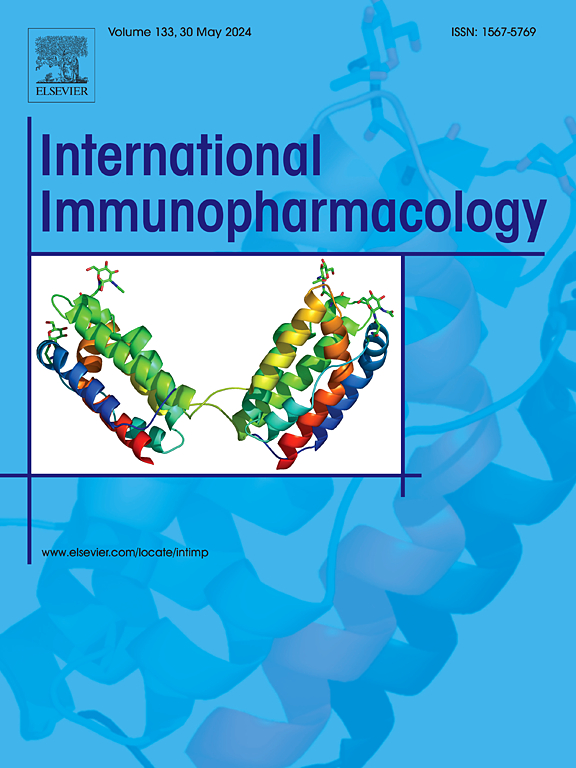Therapeutic potential of Sweroside in postmenopausal osteoporosis: Inhibition of osteoclast differentiation and promotion of osteoclast apoptosis via NF-κB and MAPK pathways
IF 4.7
2区 医学
Q2 IMMUNOLOGY
引用次数: 0
Abstract
Postmenopausal osteoporosis (PMOP) is a common metabolic bone disorder resulting from disrupted bone remodeling due to estrogen deficiency, leading to an increased risk of fractures in postmenopausal women. Sweroside, a natural compound derived from lonicerae japonicae flos, has demonstrated neuroprotective and antioxidant properties, yet its effects on PMOP remain underexplored. In vitro studies indicated that Sweroside inhibited osteoclast differentiation and bone resorption in a concentration-dependent manner. Further investigations revealed that these effects were linked to the suppression of osteoclast-specific gene expression, the modulation of the mitogen-activated protein kinase (MAPK) and nuclear factor kappa-B (NF-κB) signaling pathways, and the promotion of osteoclast apoptosis via p53 activation. Additionally, in vivo experiments using ovariectomized (OVX) mice showed that Sweroside alleviated bone loss and enhanced bone density. Overall, these findings suggest that Sweroside could be a promising therapeutic candidate for PMOP by modulating critical signaling pathways to inhibit osteoclast formation and bone resorption.
瑞草苷对绝经后骨质疏松的治疗潜力:通过NF-κB和MAPK途径抑制破骨细胞分化和促进破骨细胞凋亡
绝经后骨质疏松症(PMOP)是一种常见的代谢性骨疾病,由于雌激素缺乏导致骨重塑中断,导致绝经后妇女骨折的风险增加。从金银花中提取的天然化合物硫甙已证明具有神经保护和抗氧化特性,但其对ppu的作用仍未得到充分研究。体外研究表明,瑞草苷以浓度依赖性的方式抑制破骨细胞分化和骨吸收。进一步的研究表明,这些作用与抑制破骨细胞特异性基因表达、调节丝裂原活化蛋白激酶(MAPK)和核因子κ b (NF-κB)信号通路以及通过激活p53促进破骨细胞凋亡有关。此外,在卵巢切除(OVX)小鼠的体内实验表明,瑞草苷减轻骨质流失,提高骨密度。总的来说,这些发现表明,通过调节关键信号通路抑制破骨细胞形成和骨吸收,瑞草苷可能是一种有希望的治疗候选药物。
本文章由计算机程序翻译,如有差异,请以英文原文为准。
求助全文
约1分钟内获得全文
求助全文
来源期刊
CiteScore
8.40
自引率
3.60%
发文量
935
审稿时长
53 days
期刊介绍:
International Immunopharmacology is the primary vehicle for the publication of original research papers pertinent to the overlapping areas of immunology, pharmacology, cytokine biology, immunotherapy, immunopathology and immunotoxicology. Review articles that encompass these subjects are also welcome.
The subject material appropriate for submission includes:
• Clinical studies employing immunotherapy of any type including the use of: bacterial and chemical agents; thymic hormones, interferon, lymphokines, etc., in transplantation and diseases such as cancer, immunodeficiency, chronic infection and allergic, inflammatory or autoimmune disorders.
• Studies on the mechanisms of action of these agents for specific parameters of immune competence as well as the overall clinical state.
• Pre-clinical animal studies and in vitro studies on mechanisms of action with immunopotentiators, immunomodulators, immunoadjuvants and other pharmacological agents active on cells participating in immune or allergic responses.
• Pharmacological compounds, microbial products and toxicological agents that affect the lymphoid system, and their mechanisms of action.
• Agents that activate genes or modify transcription and translation within the immune response.
• Substances activated, generated, or released through immunologic or related pathways that are pharmacologically active.
• Production, function and regulation of cytokines and their receptors.
• Classical pharmacological studies on the effects of chemokines and bioactive factors released during immunological reactions.

 求助内容:
求助内容: 应助结果提醒方式:
应助结果提醒方式:


